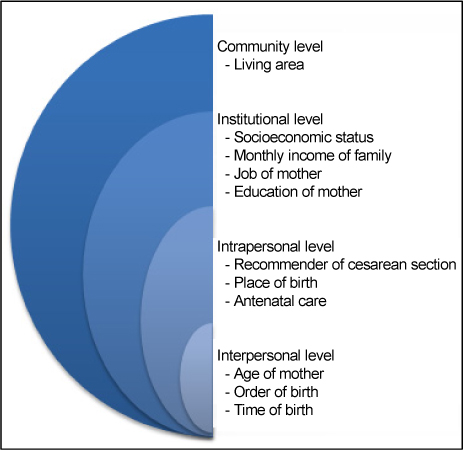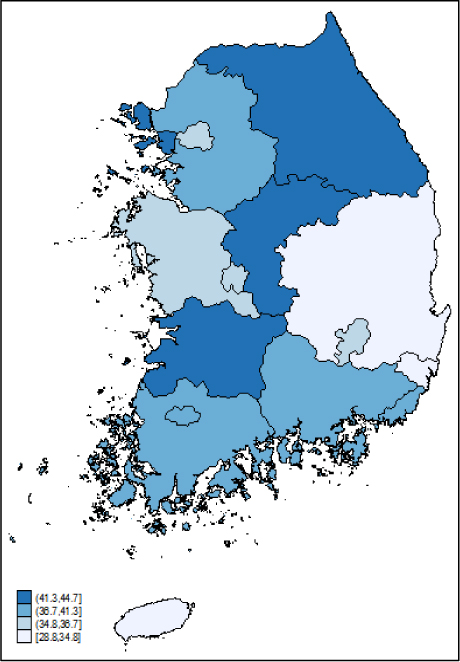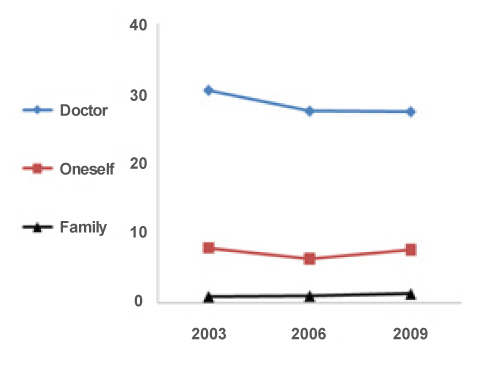Korean J Women Health Nurs.
2011 Jun;17(2):109-117. 10.4069/kjwhn.2011.17.2.109.
Impact Factors of Korean Women's Cesarean Section according to Ecological Approach
- Affiliations
-
- 1Division of Nursing Science, College of Health Science, Ewha Womans University, Seoul, Korea. leomommy@hanmail.net
- KMID: 2026283
- DOI: http://doi.org/10.4069/kjwhn.2011.17.2.109
Abstract
- PURPOSE
This study examined the impact factors of cesarean section based on the ecological approach in Korea.
METHODS
Population-based data (Korea Institute for Health and Social Affairs) were used from 2,849 delivery cases during 2003~2009. Data were analyzed using geographic statistics with STATA 10.0 and hierarchical logistic regression with SPSS/WIN 12.0.
RESULTS
The range of cesarean section rate was 28.8~44.7% with geographic distribution. The proportion of mother's problem was increasing in choice of cesarean section. According to the ecological model, age of mother (OR=1.08), time of birth (OR=0.79), delivery in hospital (OR=1.83), delivery in clinic (OR=1.46), and education of mother (OR=2.61) had significant impact on cesarean section.
CONCLUSION
This study contributes to provide the impact factors of the high cesarean rate in Korea ecologically. Policy maker and health care provider can consider these results to reduce cesarean section rate.
Keyword
MeSH Terms
Figure
Cited by 1 articles
-
Secular trends in cesarean sections and risk factors in South Korea (2006–2015)
Ho Yeon Kim, Dokyum Lee, Jinsil Kim, Eunjin Noh, Ki-Hoon Ahn, Soon-Cheol Hong, Hai-Joong Kim, Min-Jeong Oh, Geum Joon Cho
Obstet Gynecol Sci. 2020;63(4):440-447. doi: 10.5468/ogs.19212.
Reference
-
1. Ahn H.S. Cesarean section: We need a count measure. Health and Welfare Policy Forum. 2000. 6:32–33.2. Bakker R., Steegers E.A.P., Biharie A.A., Mackenbach J.P., Hofman A., Jaddoe V.W.V. Explaining differences in birth outcomes in relation to maternal age: The generation R study. BJOG: An International Journal of Obstetrics and Gynaecology. 2011. 118(4):500–509.3. Bronfenbrenner U. The Ecology of human development: Experiments by nature and design. 1979. Cambridge: Harvard University Press.4. Bujold E., Hammoud A.O., Hendler I., Berman S., Blackwell S.C., Duperron L., et al. Trial of labor in patients with a previous cesarean section: Does maternal age influence the outcome? American Journal of Obstetrics and Gynecology. 2004. 190(4):1113–1118.5. Cesaroni G., Forastiere F., Perucci C.A. Are cesarean deliveries more likely for poorly educated parents? A brief report from Italy. Birth. 2008. 35(3):241–244.6. Chhabra P., Sharma A.K., Tupil K.A. Obstetric and neonatal outcomes in women who live in an urban resettlement area of Delhi, India: A cohort study. Journal of Obstetrics and Gynaecology Research. 2006. 32(6):567–573.7. Chung J.J. Cesarean section and women's health. Gender Review. 2006. 2:42–48.8. Chung J.J. Causes of increasing rate of C-section and desirable birth environment perceived by women with C-section. Korean Journal of Women's Health. 2008. 9(1):57–85.9. Churchill H., Francome C. British midwive's views on rising cesarean section. British Journal of Midwifery. 2009. 17(12):774–778.10. Collard T.D., Diallo H., Habinsky A., Hentschell C., Vezeau T.M. Elective cesarean section: Why women choose it and what nurses need to know. Nursing for Women's Health. 2008. 12(6):480–498.11. Evaluation of appropriateness of cesarean section rate. Health Insurance Review & Assessment Service. 2011. Retrieved February 13, 2011. from http://www.hira.or.kr.12. Hwang J.Y. A clinical study of pregnancy and delivery in pregnant women 35 year and older. Dongguk Journal of Medicine. 2003. 10(2):298–306.13. Hyunh T., Alderson M. Concept analysis of human ecology. Nursing Forum. 2009. 44(2):115–128.14. Jo Y.B. Impact of hospital market competition on cesarean section rate. 2010. Seoul: Korea University;Unpublished master's thesis.15. Kim Y.M., Ko S.K. Factors determining cesarean section frequency rates of the OBGY clinics in metropolitan area. Korean Journal of Women Health Nursing. 2002. 8(3):389–401.16. Korean health and welfare information. Korea Institute for Health and Social Affairs. 2011. Retrieved February 11, 2011. from http://www.kihasa.re.kr.17. Census of population trends. Korea Statistical Information Service. 2011. Retrieved February 11, 2011. from http://www.kosis.kr.18. Lee K.H., Lee Y.S., Ko M.S., Kim H.J., Park N.J., Park Y.J., et al. Maternity & women's health nursing. 2010. 2nd ed.Seoul: Hyunmoonsa.19. Lee K.Y. Suggestion for reducing cesarean section rate. The Korean Association of Obstetricians and Gynecologists Symposium. 2003. 89:74–79.20. Logsdon M.C., Gennaro S. Bioecological model for guiding social support research and interventions with pregnant adolescents. Issues in Mental Health Nursing. 2005. 26(3):327–339.21. McLeroy K.R., Bibeau D., Steckler A., Glanz K. An ecological perspective on health promotion program. Health Education Quarterly. 1988. 15:351–377.22. Menacker F., MacDorman M.F., Declercq E. Neonatal mortality risk for repeat cesarean compared to vaginal birth after cesarean (VBAC) deliveries in the United States, 1998-2002 birth cohorts. Maternal and Child Health Journal. 2010. 14(2):147–154.23. Novilla M.L., Barnes M.D., De La Cruz N.G., Williams P.N. Public health perspectives on the family: An ecological approach to promoting health in the family and community. Family & Community Health. 2006. 29(1):28–42.24. Seo K. Actual condition and trend of cesarean section rate. The Korean Association of Obstetricians and Gynecologists Symposium. 2003. 89:59–63.25. Tschudin S., Alder J., Hendriksen S., Bitzer J., Popp K.A., Zanetti R., et al. Pregnant women's perception of cesarean section on demand. Journal of Perinatal Medicine. 2009. 37(3):251–256.26. Vecino-Ortiz A.I., Bardey D., Castano-Yepes R. Small-area variation in health care affecting the choice of cesarean delivery: The case of a Colombian health insurer. Serie Documentos de Trabajo. 2009. 73(1):1–23.27. Wilcox P. An ecological approach to understanding youth smoking trajectories: Problems and prospects. Addiction. 2003. 98:Suppl 1. 57–77.28. Appropriate technology for birth. Lancet. 1985. 2:436–437.29. Xirasagar S., Lin H.C., Liu T.C. Do group practices have lower caesarean rates than solo practice obstetric clinics? Health Policy and Planning. 2006. 21(4):319–325.
- Full Text Links
- Actions
-
Cited
- CITED
-
- Close
- Share
- Similar articles
-
- Maternal Hypotension with Regional Anesthesia for Elective Cesarean Delivery: Risk factor and Impact on Neonate Outcome
- Factors Determining Cesarean Section Frequency Rates of the OBGY Clinics in Metropolitan Area
- A Study on the Effect of Physician Characteristics on the Cesarean Section Rate
- Endometriosis of the Abdominal Wall Secondary to Cesarean Section
- General Anesthesia for Cesarean Section of a Parturient with Aplastic Anemia Refractory to Platelet Transfusion





